Last Updated: March 8, 2024 Kamlesh Nayal
India is one of the major spiritual centres in the world with its plethora of temples and other religious sites that have today become the cynosure of world’s eyes. These spiritual sites not only attract pilgrims from different corners of India and the world but, also lures many knowledge seekers, researchers and curious travellers who are keen to get an insight in India’s rich spiritualistic and Vedic history.
Here is a list of some major spiritualistic and religious centres of North India that are worth visiting at least once in your lifetime:
Amarnath Cave, Jammu & Kashmir
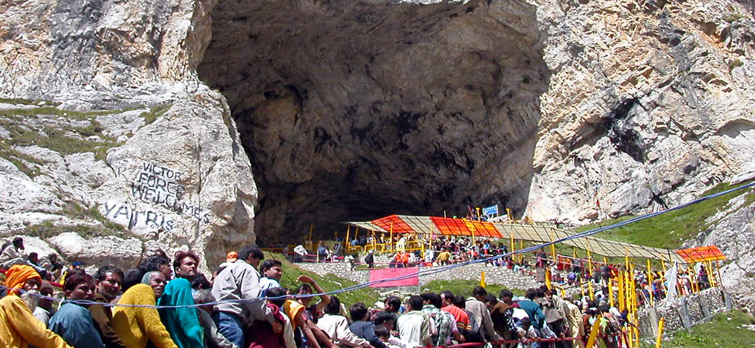
One of the most sacred shrines for Hindus, the holy ‘Amarnath Cave’ is located in a narrow gorge at the end of the ‘Lidder Valley’ in the state of Jammu & Kashmir. Covered with snow for most of the year, the cave gets accessible to pilgrims for only a short duration in summers around the festival of Shravani Mela in July and August. It is believed that Lord Shiva unrevealed the secrets of life, death, moksha and immortality to Goddess Parvati in this holy cave. Large number of devotees gather here to get the divine darshans of the natural Shivlinga formed from ice in this cave.
Abode of Lord Shiva, the cave can be reached through a strenuous climb from Srinagar via Pahalgam or Baltal (Sonamarg). Chandanwari forms the major stopover along the Srinagar-Pahalgam-Chandanwari-Amarnath route. It is believed that Lord Shiva left his moon (Chand) at Chandanwari on his way to Amarnath and hence, this place got its name. Pilgrims can reach Chandanwari through various options of road transport from Srinagar and it is at Chandanwari from where a steep climb of around 16km. needs to be covered on foot or ponies to reach the Amarnath cave. The magic of picturesque vistas and an aura of complete spirituality and divinity all along the route helps the pilgrims forget all their fatigue, giving them an indescribable sense of motivation and power to reach their destination. Click here for Amarnath Yatra by Helicopter Tour Itinerary.
Following are some of the major attractions of religious importance that can be seen along the route from Chandanwari to Amarnath:
- Pissu Top – The ‘Pissu Top’ lies at only few kilometres from Chandanwari and the hike is so steep that even professional hikers sometimes seem to be struggling with the challenge of the climb. As per the legends, Pissu Top lies at top of the hill that was formed from the bones of Asuras who were killed by Devtas during a big battle.
- Sheshnag Valley – At a distance of around 9 km. from Pissu Top, pilgrims reach their next stopover, the ‘Sheshnag Valley’. Mesmerizing views of the snow-covered mountains, turquoise blue lake and the Lidar glacier take your breath away once you reach the serene Sheshnag Valley. It is believed that it is at this valley where Lord Shiva left his Sheshnag before heading to the Amarnath Cave with Goddess Parvati. It is said that true devotees still get the darshans of Sheshnag at the Sheshnag Lake.
- Mahagunas Pass – From Sheshnag, the next major milestone is at the ‘Mahagunas Pass’ or the ‘Ganesh Top’, the highest altitude point of the pilgrimage. Leaving behind Lord Ganesha here, Lord Shiva and Goddess Parvati made their way to the holy Amarnath Cave. The path leading to Mahagunas Pass from Sheshnag is considered to be the most dangerous climb of the Amarnath Yatra with huge boulders, sharp rocks and deep valleys along the route.
- Panchtarni – From the Mahagunas Pass, a descend starts and Panchtarni lies at a distance of 3.4 km. Known for the five rivers that are believed to have been originated from the hairs of lord Shiva, Panchtarni gets its name. Also, as per the legends Lord Shiva here left the five elements of human life (earth, fire, water, air and sky). Located on the foothills of Mt. Bhairav, captivating views of the surrounding area remain in your memories forever.
- Amarnath Cave – At a distance of 6km. from Panchtarni, lies the final destination, the holy Amarnath cave. Pilgrims perform Pooja inside the cave and pay homage to the Swayambhu ice Shivlinga. The divine aura inside the cave is strong enough to magnetize your minds and souls.
Vaishno Devi, Jammu & Kashmir
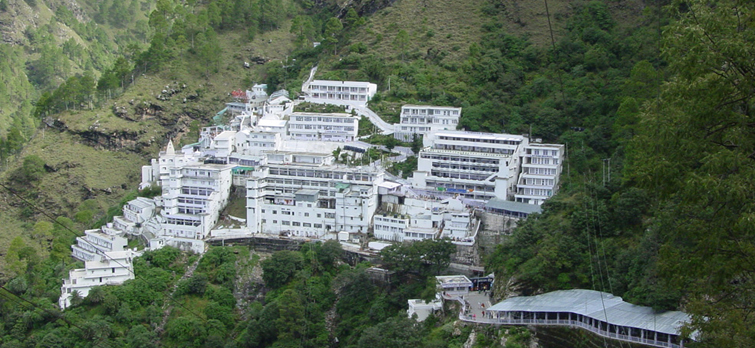
Another one of the most revered Hindu pilgrimage destinations in India, is the holy shrine of Mata Vaishno Devi located on the ‘Trikoot Parvat’ near Katra in Jammu and Kashmir. Thousands of devotees from all across India and different corners of the world visit the temple every year. Three forms of Goddess Durga in shape of three natural rock formations known as ‘Pindies’ are worshipped in the cave of Mata Vaishno Devi.
The holy ‘Vaishno Devi Yatra’ starts from the base camp of Katra, covering a distance of almost 12km. Pilgrims need to cover the distance on foot. For those not in prime of health, ponies and palkis can be rented from Katra. Private helicopter services can also be booked from Katra, which ply till ‘Sanjhi Chhat’ from where the remaining distance needs to be covered on foot. The hilly roads to the holy cave are in quiet good conditions with rest houses, dhabas and eateries lined at various places across the route. Panoramic views, aesthetic natural beauty and loud chants of ‘Jai Mata Di’ filling the air, gets you going to your final destination. Besides the main temple of Vaishno Devi, here are other sites that can be visited in and around Katra.
- Ban Ganga – This is the first stop in Katra from where the actual Vaishno Devi Yatra begins. The sacred Ganga River flows at this place and before starting the pilgrimage, devotees take a dip in the holy waters of the river. According to the legends, Mata Vaishno Devi, while on her way to the holy cave stopped here and using an arrow (or ‘Ban’ in Hindi) made River Ganga to appear and hence, the name ‘Ban Ganga’. Goddess Vaishno Devi also washed her hair (‘Bal’ in Hindi) in this water stream and therefore, the place is also known as ‘Bal Ganga’.
- Charan Paduka – Located at a distance of 1 km. from Ban Ganga, it is believed that Vaishno Mata stopped here and looked back to see if Bhairav Nath is chasing her. Her footprints got engraved here and the place came to be known as ‘Charan Paduka’. A small temple is built here which is visited by all pilgrims on their way to the holy cave.
- Ardhkuwari – Ardhkuwari marks the mid-point of the journey. According to legends, Goddess Vaishno Devi resided in this womb shaped cave for 9 months and prayed to Lord Shiva. The cave at Ardhkuwari is famously known as ‘Garbh Joon’ because of its resemblance to the shape of womb. The place is an important stopover along the journey. It is believed that even the fattest of the persons on earth can easily get through the narrow cave of Ardhkuwari.
- Bhairav Nath Temple – After paying the homage to Mata Vaishno Devi at her holy shrine, pilgrims visit the ‘Bhairav Nath Temple’, located in ‘Bhairav Ghati’ at a distance of 5km from Vaishno Devi temple. It is believed that the yatra remains incomplete if a visit is not made to this temple. Views of surrounding mountains and forests captivate your hearts and souls from the Bhairon temple.
- Patnitop – A beautiful hill station located in Udhampur district of Jammu and Kashmir, Patnitop attracts lots of tourists, especially the honeymoon couples visiting the Vaishno Devi temple. Serenity of this lush meadow surrounded with mountains and thick woods of pines, acts as a perfect destination to spend some relaxing time in the lap of Mother Nature.
Yamunotri, Uttarakhand
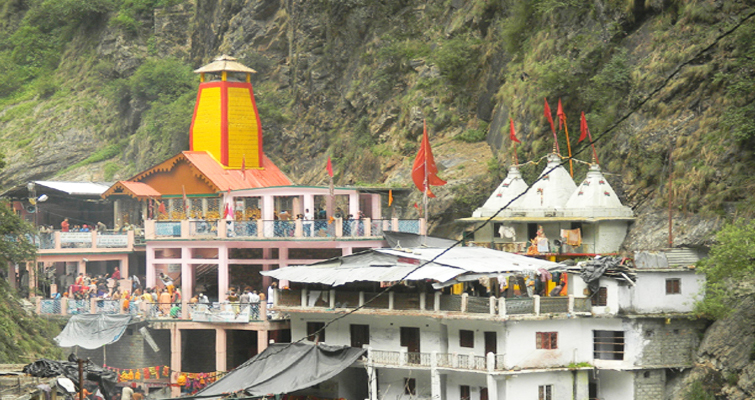
One of the 4 pilgrim destinations of the ‘Chhota Char Dham Yatra’ in Uttarakhand, Yamunotri marks the holy abode of Goddess ‘Yamuna’. Home to the originating point of River Yamuna, one of the sacred rivers for Hindus, the place is visited by thousands of pilgrims every year. According to Hindu mythology, whoever takes bath in waters of River Yamuna gets a painless and peaceful death. Following is a list of main tourist attractions in and around Yamunotri.
- Hanuman Chatti – Located 6km. short of Yamunotri, Hanuman Chatti is the base camp for trekking to Yamunotri. Trekkers either start their trek from this point or take a jeep or taxi till Janki Chatti from where the distance of the trek reduces by 2km. A small ‘Hanuman Temple’ at Hanuman Chatti is a must visit enroute to Yamunotri.
- Janki Chatti – Known for its hot water springs where pilgrims can take bath and get relieved from their fatigue, this is the place from where the actual climb till Yamunotri starts. This is also the point from where palanquins and ponies can be hired.
- Kharsali – Located at a distance of 1 km. from Yamunotri, Kharsali is a quaint little village and the winter home to Goddess Yamuna. When the main Yamunotri temple gets closed in winters, the main deity of Yamunotri temple is brought a Kharsali and is worshipped here for almost 6 winter months. The place is also known for its ancient ‘Shani Dev Temple’ made of stones, wood and a unique mortar made of Urad Daal.
- Yamunotri Temple – This the main shrine dedicated to Yamuna Ji. The deity of Goddess Yamuna is in the form of a silver idol bedecked with garlands.
- Surya Kund – Located close to the main Yamunotri temple, Surya Kund is a natural hot water spring named after Sun God, father of Goddess Yamuna. Before visiting the main temple, there is a custom of first bathing and preparing the Prasad of rice and potatoes in the waters of this spring. The Prasad is then offered to the deity of Yamuna Ji in Yamunotri Temple.
- Divya Shila – After preparing Prasad at the Surya Kund, pilgrims first need to pay homage to this rock pillar before entering the Yamunotri Temple.
- Champasar Glacier – This is the main point from where river Yamuna originates. Located few km. further up the Yamunotri Temple and owing to its steep climb and limited accessibility, the glacier is visited by only few brave-hearted pilgrims.
Yamunotri Temple Opening Date: May 10, 2024
Gangotri, Uttarakhand
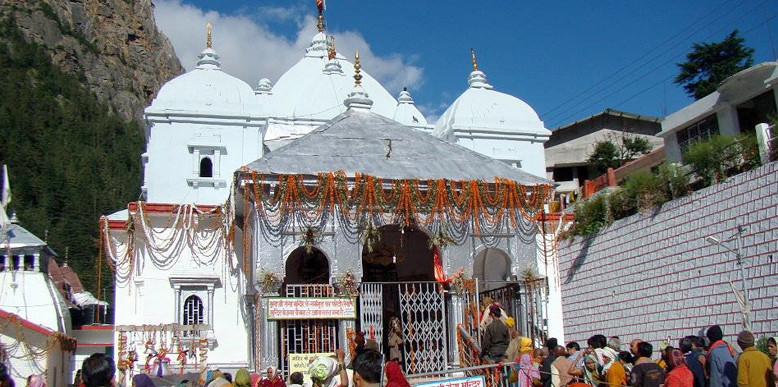
Second of the 4 pilgrim destinations of the ‘Char Dham Yatra’ in Uttarakhand, Gangotri marks the holy abode of Goddess ‘Ganga’, the most sacred river of Hindus. Home to the originating point of Ganga River, this is one of the most spiritual places for Hindus in the world. It is believed that taking a dip in holy waters of Ganga can relieve you from the vicious cycle of life and death. Unspoilt natural charm, mesmerizing scenic vistas and a fresh mountain air along with the chants of ‘Jai Ma Gange’ echoing in the ears, makes you feel connected with a divine power as you head towards Gangotri. Here are some must see attractions in and around Gangotri.
- Ganga Temple, Mukhba Village – Located at a short distance from Gangotri in the town of Harsil, Mukhba is a small village that is a home to Goddess Ganga during winters. Main idol of Ganga is brought to the ‘Ganga Temple’ in this village where it is worshipped for 6 months of winters.
- Bhairon Temple, Bhairon Ghati – Located 10 km. short of Gangotri, it is a scenic valley known for its ancient ‘Bhairon Baba Temple’. Pilgrims on their war to Gangotri make it a point to pay their homage to Bhairon Baba in this temple.
- Gangotri Temple – This is the main shrine where Goddess Ganga is revered.
- Submerged Shivlinga – A natural rock Shivlinga submerged under water which is believed to be the seat of Lord Shiva when he took Ganga in his matted locks to protect earth from devastation because of the rigorous flow of her waters.
- Gaumukh Glacier – This is the main originating point of River Ganga located 18 km. ahead of Gangotri. An arduous trek full of scenic vistas and mesmerizing views of the Himalayas is a must if you are in pink of health. Make sure to check weather conditions and take permit from the Uttarakhand forest department before commencing this trek.
- Tapovan & Nandanvan – Further few kms ahead of the Gaumukh Glacier, scenic sites of Tapovan and Nandanvan offering mesmerizing views of the Shivling Peak can be reached. This trek is only meant for brave hearts and courageous people as the path is prone to accidents and natural calamities.
Gangotri Temple Opening Date: May 10, 2024
There are many more attractions in the vicinity like the ‘Pandava Gufa’, ‘Suryakund Waterfalls’ etc. You can visit them if time permits.
Kedarnath, Uttarakhand
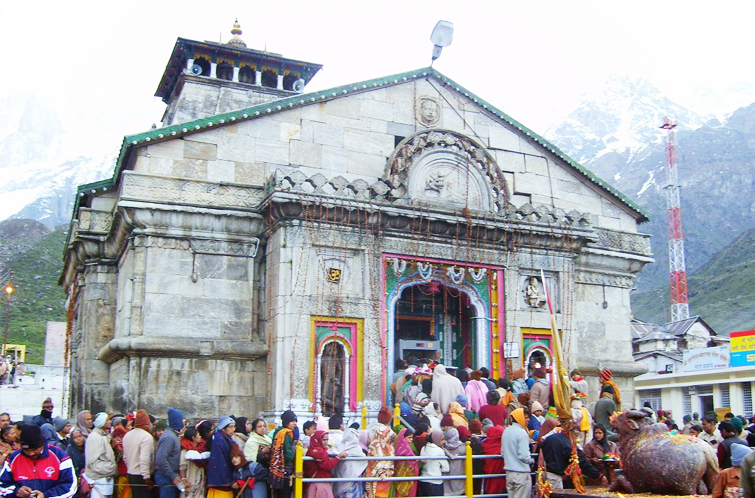
One of the most revered pilgrim destinations for Hindus, Kedarnath is the home to one of the 12 Jyotirlingas of Lord Shiva and also forms the 3rd dham of the Char Dham Yatra. The place is visited by uncountable number of pilgrims every year seeking spiritual bliss and salvation from an unending cycle of life and death. Following are main tourist attractions in and around Kedarnath.
- Omkareshwar Temple, Ukhimath – Scenic village of Ukimath is located a short distance before Kedarnath. The ‘Omakreshwar Temple’ in Ukhimath acts as the winter home to Lord Kedarnath who is worshipped here owing to the closure of main Kedarnath Temple.
- Gauri Kund – Located 20 km. short of Kedarnath, this is the base site from where trekking needs to be commenced till Kedarnath. Pilgrims first take bath in the natural thermal waters of Gaurikund, pay their homage to Goddess Parvati in the ‘Gauri Temple’ and then proceed to Kedarnath.
- Kedarnath Temple – This is the main shrine of Lord Shiva who is revered in the form of Kedarnath. Home to one of the 12 Jyotirlingas and considered to be one of the ‘Panch Kedars’, the temple holds a great religious significance for Hindus and devotees of Lord Shiva.
- Vasuki Tal – Located at a distance of 8 km. from Kedarnath Temple, Vasuki Tal is the place where Lord Vishnu is believed to have bathed in ancient times.
- Shankaracharya Samadhi – Adi Guru Shankaracharya is the main spiritual guru of Hindus. He took nirvana at the age of 32 at Kedarnath. His body was merged under the land where his Samadhi resides today. The statue of Guru Shankaracharya was washed away in massive flash floods in 2013 but the site has now been fully restored.
- Bhairav Temple – Lord Bhairavnath is believed to guard Kedarnath Valley during winters when everything is covered under the snow. The temple is dedicated to Lord Bhairavnath and can be reached via a 1km. trek from Kedarnath Temple.
Kedarnath Temple Opening Date: May 10, 2024
Badrinath, Uttarakhand
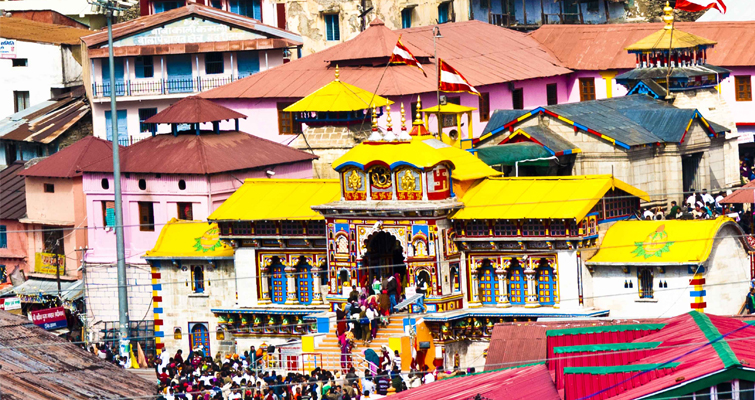
Last of the four dhams of the ‘Chhota Char Dham Yatra’ in Uttarakhand, Badrinath is the holy abode of Lord Vishnu. According to Puranic legends, Lord Vishnu performed a great penance here and his consort, Goddess Lakshmi, took the form of berry trees to shade him from the harsh sun. ‘Badri’ is the local name for berries and hence, this place came to be known as ‘Badrinath’. Best sightseeing places in and around Badrinath include the following.
- Badrinath Temple – This is the main shrine where Lord Vishnu is revered in the dual form of Nar and Narayana. One of the most holy shrines for Vaishnavites, the temple is located in Garhwal Hills on the banks of the Alaknanda River in Uttarakhand. Breath-taking beauty of the surroundings and captivating views of Himalayas from the temple make your hearts stop for a while.
- Tapt Kund – A natural hot water spring where pilgrims take a holy dip before entering the main shrine. The water is also believed to contain curative properties.
- Mana Village – This is the scenic village associated with Rishi Vyas, author of Mahabharata and Lord Ganesha, who helped sage Vyas to write Mahabharata in a tremendous speed. ‘Vyas Cave’ and ‘Ganesh Temple’ residing in the village are worth visiting.
- Vasudhara Falls – Located at a distance of 6 km. from the Mana Village, these beautiful falls offer captivating views of snow clad Himalayas and glaciers feeding the Alaknanda River.
- Neelkanth Peak – One of the highest peaks of the Garhwal region, the Neelkanth peak lies at a distance of 9 km. east of Badrinath. The peak is believed to be the abode of Lord Shiva and serves as a scenic backdrop for the Badrinath Temple.
- Charan Paduka – Located at a distance of 3 km. from the Badrinath Temple, this is the huge boulder with engraved footprints of Lord Vishnu.
- Brahma Kapal – A flat boulder located on the banks of Alaknanda River, this is the place where Hindus pray and perform rituals for salvation of departed souls of their ancestors.
- Sheshnetra – This is another remarkable holy site in Badrinath where a huge rock has natural imprints of an eye of Sheshnag, the snake on which Lord Vishnu takes his retreat.
- Mata Murti Temple – This temple is dedicated to Mata Murti, mother of Lord BadriNarayan. According to mythological beliefs, Lord Vishnu took birth in the form of Nar and Narayan from the womb of Mata Murti to kill a demon.
Badrinath Temple Opening Date: May 12, 2024
Haridwar, Uttarakhand
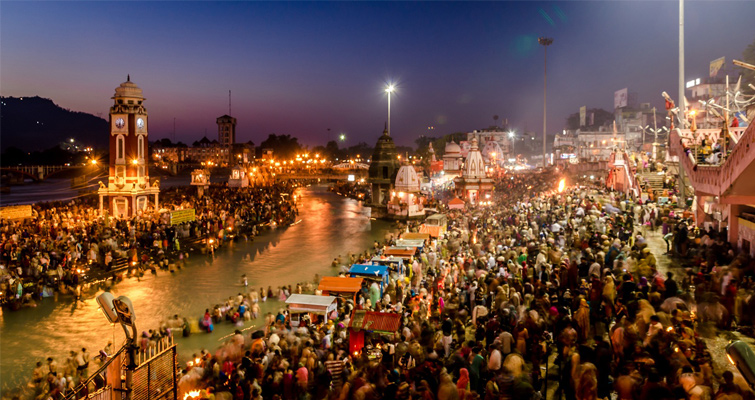
Haridwar or the ‘Gateway to God’, is one of the most sacred pilgrim destinations in India. Located on the foothills of Himalayas and banks of holy Ganga River in the state of Uttarakhand, Haridwar attracts umpteen number of pilgrims, travellers and holiday seekers from across India and different corners of the world. Pilgrims travel to this holy city from far-off locations to take bath in holy waters of the sacred river to absolve their sins. Haridwar is also one of the 4 pilgrim destinations in India where ‘Kumbh Mela’ is organized on a rotation basis. Magical charm of the city with its bustling markets lined up with small eateries and curio shops, ghats crowded with pilgrims and sadhus and sounds of temple bells echoing in the ears; takes you in its full spirits. Here are some major tourist attractions of Haridwar.
- Har ki Pauri – One of the most famous and most holy places in Haridwar, Har ki Pauri acts as the host for enchanting evening Ganga Aarti. View of the lighted diyas floating on the river surface, echoing chants of the prayers and aroma of the incense makes you feel as if you have reached a different world altogether. The place is also the most preferred destination for pilgrims to take dip in the holy waters of Ganga to absolve their sins.
- Mansa Devi Temple – Situated on a hilltop, Mansa Devi Temple is dedicated to Goddess Mansa (wish fulfilling Goddess). Pilgrims and tourists visiting Haridwar make it a point to visit this temple to have their wishes fulfilled by tying a thread on the branches of the sacred tree in the temple premises.
- Chandi Devi Temple – One of the other most famous temples of Haridwar, Chandi Devi Temple is perched on the Neel Parvat and can be reached through the ropeway that starts near the Gauri Shankar temple in Haridwar. Goddess Durga in the form of Chandi (manifestation she took to kill the demons Shumbh and Nishumbh) is revered in this temple. Also, considered to be one of the Siddha Shaktipeeths, pilgrims visit the temple to seek the blessings of Goddess.
- Maya Devi Temple – Dedicated to Goddess Maya, the temple is also one of the 52 Shakti Peeths where navel and heart of Goddess Sati is believed to have fallen. The presiding deity of the temple is three headed and four armed form of Shakti or Durga. Maya Devi Temple, along with Mansa Devi Temple and Chandi Devi Temple forms the Siddha Shaktipeeths where wishes of true devotees are fulfilled.
- Sapt Rishi Ashram – One of the oldest and most beautiful ashrams of Haridwar, the ‘Sapt Rishi Ashram’ today stands on the holy site where River Ganga split her in seven channels in order to lower the thunderous sound of her gushing waters disturbing the seven rishis engrossed in deep meditation. Located at a distance of 5 km. from Har ki Pauri, the Sapt Rishi Ashram serves as a home to many rishis, saints and sages visiting Haridwar from different corners of the country. Regular Yoga and meditation classes are also held in this ashram.
- Patanjali Yogpeeth – The famous Patanjali Yogpeeth run by Baba Ramdev is another great tourist attraction in Haridwar. One of the main Yoga and Meditation centres of the world, the place is visited by many tourists, pilgrims and yoga enthusiasts.
- Rajaji National Park – Located at a distance of 10km from Haridwar, the Rajaji National Park is known for its indigenous flora and fauna and a wide variety and wild animals and birds. The park is the second best tiger reserve in Uttarakhand after the Corbett National Park. Jungle safaris inside the park can be arranged by the Uttarakhand forest department.
Besides the above attractions, the list of temples in Haridwar is endless; it can take ages to cover all of them.
Rishikesh, Uttarakhand
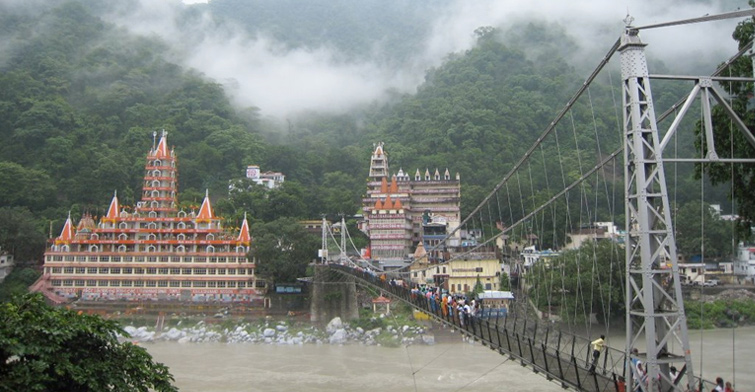
Another sacred pilgrim destination for Hindus, Rishikesh is situated on the foothills of Himalayas on the banks of Ganga River in Dehradun district of Uttarakhand. Also named as the ‘World’s Yoga Capital’, the place is dotted with numerous Yoga and meditation centres. Rishikesh is also home to various ashrams and is a hub of adventure activities like white water river rafting, mountain climbing and river rappelling. Here are some major attractions of Rishikesh.
- Neelkanth Mahadev Temple – According to mythological legends, Lord Shiva, in order to protect the universe, consumed the poison that originated from Samudra Manthan. This act turned his throat blue making him to be called as ‘Neelkanth’. This manifestation of Lord Shiva as Neelkanth Mahadev is revered in the Neelkanth Mahadev Temple.
- Trimbakeshwar Temple – A 13 storeyed temple with each floor dedicated to a different form of Lord Shiva, the ‘Trimbakeshwar Temple’ is one of the most famous attractions of Rishikesh. Thousands of pilgrims visit this temple every day.
- Triveni Ghat – Located on the confluence of three holy rivers: Ganga, Yamuna and Saraswati, the ghat is the holiest spots of Rishikesh. Thousands of pilgrims take a holy dip in the waters of the triveni confluence. Maha Aarti of Goddess Ganga every evening on the Triveni Ghat is an added attraction.
- Swarg Ashram – It is a spiritual community comprising of various ashrams, temples and bazaars. Lots of pilgrims coming to Rishikesh stay in one of the ashrams of Swarg Ashram. With Ganga River flowing right in front of the ashram, makes it one of the most serene places in Rishikesh.
Mathura-Vrindavan, Uttar Pradesh
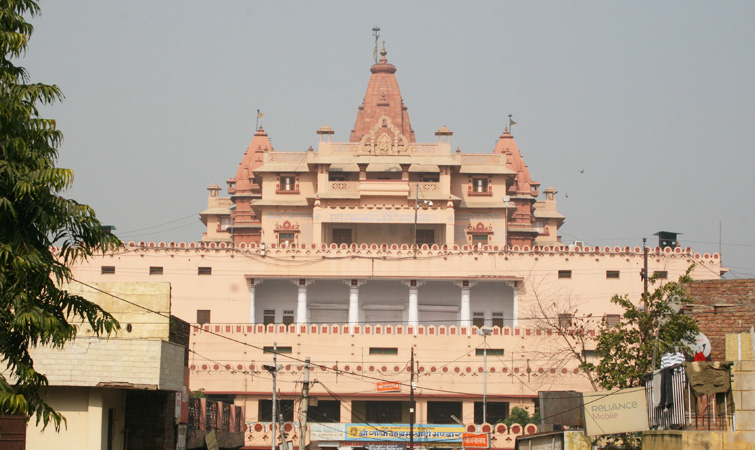
The twin cities of Mathura and Vrindavan are associated with Lord Krishna. Located on the banks of River Yamuna in the state of Uttar Pradesh, Mathura is the place where Krishna was born and Vrindavan is where he spent his childhood and early youth. Many folktales of Radha and Krishna revolve around the city of Vrindavan. One of the important pilgrimage centres for Hindus, these holy cities are thronged by millions of pilgrims every year particularly during festivals of Janmashtmi and Holi. Here are some famous attractions not to be missed during your visit to these holy cities.
- Krishna Janmabhoomi Temple, Mathura – One of the most sought after tourist attractions in Mathura, the ‘Krishna Janmabhoomi Temple’ is distinguished as the birthplace of Lord Krishna. It is well known that Lord Krishna was born in a prison cell to Devki and Vasudeva. The temple is located at the same location and is visited by thousands of pilgrims who come here to seek blessings of the Lord.
- Dwarkadheesh Temple, Mathura – One of the other must-visit temples in Mathura is the Dwarkadhish Temple, where along with Lord Krishna who is revered in the form of king of holy city Dwarka, his beloved Radha is also worshipped. Intricate carvings and exquisite paintings adorning the walls of the temple are worth noticing.
- Kansa Qila, Mathura – This is an old fort linked as being the residence of Krishna’s maternal uncle, Kansa in Vedic times. The fort was re-built by Maharaja Man Singh of Jaipur and later an observatory was constructed in the fort by Raja Sawai Jai Singh of Amer. The fort today stands in ruins.
- Vishram Ghat, Mathura – This is the most sacred ghats in Mathura where Lord Krishna is believed to have taken rest for some time after killing his uncle, Kansa. Aarti of Yamuna Ji every evening held at Vishram Ghat, Mathura is a true spectacle with hundreds of floating diyas, aroma of incense and loud chanting of the prayers.
- Bankey Bihari Temple, Vrindavan – Shri Bankey Bihari Temple is the most visited and holiest temple in Vrindavan. Lord Krishna is worshipped in the form of ‘Nand Gopal’, the childhood manifestation of Lord Krishna. One cannot have continuous darshans of the Lord in this temple as curtains are drawn every few seconds because of the belief that anyone who sees the Lord for a long time will lose his consciousness.
- Rangaji Temple, Vrindavan – Another of the famous temples in Vrindavan is the Rangaji Temple, where Krishna is revered here in the form of Lord Ranganatha. Lord Krishna who is a manifestation of Lord Vishnu along with his consort, Goddess Lakshmi, is seen here resting on the coils of Sheshnag. Constructed in a South Indian style of architecture with 8 tall gopurams adorned with intricate carvings, this temple is a must visit.
- Goverdhan Hill, Govardhan – Located at a distance of 8km. from Vrindavan, the Govardhan Hill holds a great religious significance for devotees of Lord Krishna. Folktale of Lord Krishna lifting the entire Govardhan Hill on his little finger to save the people from devastation caused by Indra God, is known to all. Pilgrims from across the world travel to this place for circumambulation of this holy hill.
- Radha Kund – This sacred kund is located near Govardhan and it is believed that Radha Rani used to bathe in its waters. According to Padma Purana, Radha Kund is filled with ecstatic love for Lord Krishna and whosoever takes a dip in its holy waters is also blessed with love and mercy of the lord.
- Kusum Sarovar, Govardhan – This serene water body is worth visiting near Govardhan. The Kusum Sarovar is surrounded by numerous Kadamb trees. Not known to many, this is the place from where Radha along with other gopis used to pick flowers and meet Krishna. Peaceful and tranquil settings of the place make it worth visiting during your trip to Mathura-Vrindavan.
Varanasi, Uttar Pradesh
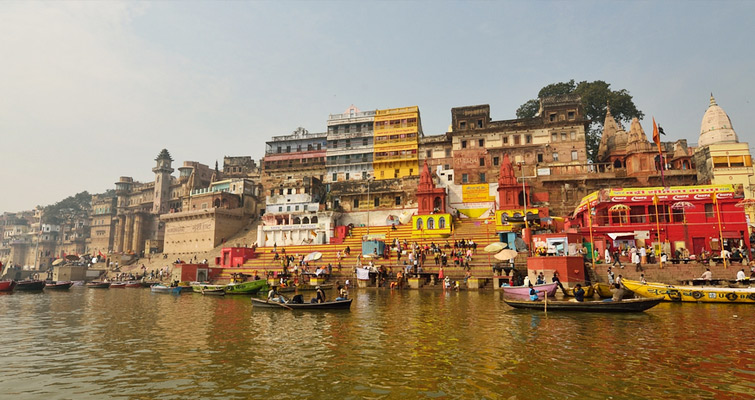
Nicknamed as the ‘City of Temples’, Varanasi is acclaimed to be one of the oldest cities in the world, situated on the banks of holy River Ganges in state of Uttar Pradesh. Once known as Benaras or Kashi, Varanasi is the most sacred city and spiritual centre for Hindus. Believed to have been created by Lord Shiva himself, many people come to Varanasi to spend their last days so as to attain salvation from the cycle of life and death. The city is a magnet for pilgrims, travellers, knowledge seekers and historians alike. Electrifying sounds of the temple bells, echoing chants and hymns of the temple prayers and a fragrance of incense in the air of the city; is sure to make you connect with your spiritual self. A visit to Varanasi is incomplete without visiting the following attractions.
- Kashi Vishwanath Temple – The temple dedicated to Lord Shiva is one of the most sacred temples of the city. Home to one of the 12 Jyotirlingas, Kashi Vishwanath Temple holds a great religious significance for Hindus. Endless number of pilgrims from all over the world throng to this temple every year, particularly during the festivals of ‘Shivratri’ and ‘Maha Shivratri’ to seek blessings of the God.
- Kaal Bhairav Temple – Kaal Bhairav is believed to be a manifestation of Lord Shiva who is guarding the holy city of Varanasi. It is believed that Kaal Bhirav absolves the sins of his true devotees. Pilgrims visiting the holy city of Varanasi make it a point to visit the temple of Kaal Bhairav.
- Vishalakshi Temple – Dedicated to Goddess Vishalakshi (manifestation of Goddess Parvati), the temple is one of the 52 Shakti Peeths where eyes and earrings of Mata Sati is believed to have fallen. It is believed that worshipping Vishalakshi Mata fulfils the wish of children to childless couples and a nice groom to unmarried girls. There is a huge rush in the temple during the festival of Navratri and Kajali Tij.
- Annapurna Mata Temple – Goddess of nourishment, Maa Annapurna (form of Goddess Parvati) is the main deity of the Annapurna Mata Temple, located adjacent to the Kashi Vishwanath Temple. Two idols of Goddess Annapurna, one made of Gold and other made of Brass are housed in the temple. The idol made of Gold is opened to public only once in a year i.e. on the festival of Annakut.
- Dashashwamedh Ghat – Dashashwamedh Ghat is the main and most spectacular ghat of the Varanasi city. Located close to the Kashi Vishwanath Temple, the ghat is thronged by huge number of pilgrims during evening when special aarti is held on the banks of the river Ganga. Enchanting views of hundreds of lighted diyas floating on the surface of the river with loud chants of aarti reverberating in the air, is a spectacle to capture in your memories for lifetime.
- Manikarnika Ghat – One of the oldest ghats of Varanasi, Manikarnika Ghat is the main ghat where cremation and other rituals for the dead are performed. It is believed whosoever gets a cremation on this ghat immediately attains salvation.
- Panchganga Ghat – This ghat sits on the confluence of 5 holy rivers: Ganga, Yamuna, Saraswati, Dhutpapa and Kirana. Panchganga Ghat is also one of the two cremation ghats of Varanasi.
- Ramnagar Fort – Located at a distance of 14km from Varanasi, the Ramnagar Fort attracts lots of history buffs and curious travellers. Made of red sandstone in Mughal style of architecture, a part of this fort still serves as the residence for the descendants of Maharaja of Varanasi. The fort also houses a museum and ‘Ved Vyasa Shrine’. During the Dussehra festival, Ramlila is organized on the grounds of this fort; final Ravan Dahan is also held here.
The neighbouring eastern states of Bihar and Jharkhand also have some interesting and popular religious places to visit. Since the two states are at a short distance from North Indian state of Uttar Pradesh, it is a good idea to add them to our pilgrimage tour of North India. Here is the detailed list for you:
Bodhgaya, Bihar
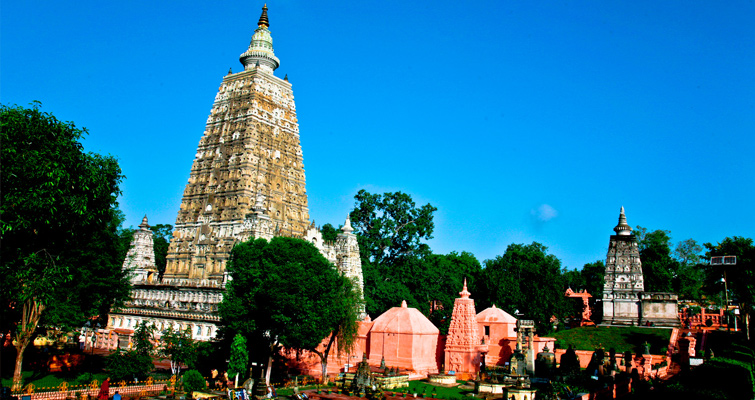
Located in Gaya district of Bihar, Bodhgaya is the most sacred pilgrim destinations in the world for Buddhists. It is at this very place where Lord Buddha attained enlightenment. Monks and thousands of Buddhist pilgrims from all across the world visit this holy city every year. Listed below are some of the main tourist attractions at Bodhgaya.
- Mahabodhi Temple – Believed to have been built by Emperor Asoka in the 3rd century BC, the temple now enjoys a status of UNESCO World Heritage site. One of the earliest Buddhist temples built entirely of brick, the temple is an architectural masterpiece with a finely engraved pyramidal shaped tower. The outer walls of the temple adorn brick carvings of the scenes from the life of Gautama Buddha. Inner hall of the temple houses a 1700 year old gold plated statue of Lord Buddha seated in a glass enclosure.
- Bodhi Tree – Near to the main Mahabodhi Temple, is located the holy Bodhi Tree, a fifth descendent of the original Bodhi Tree under which Gautama Buddha meditated to attain enlightenment. Below the tree, you will find a large rectangular slab covered with a gold canopy. This slab is known as ‘Vajrasana’ or the meditative position of Lord Buddha when he was meditating under the tree.
- Great Buddha Statue – Located next to Mahabodhi Temple, this imposing 80 feet statue of Lord Buddha can be seen seated in a meditating pose on a giant lotus with smaller statues of his close disciples on it’s both sides. The statue is symbolic to Bodhgaya and is visited by many pilgrims visiting the holy city.
- Animeshlochana Chaitya Temple – This temple is a miniature of the Mahabodhi Temple and is believed that standing here in an unblinking position, Lord Buddha gazed at the Bodhi Tree for about a week.
- Muchalinda Lake – Part of the Mahabodhi Temple complex, this serene lake is located on the right side of the main temple. According to legends, the snake king of the lake, Muchalinda protected Gautama Buddha from a huge storm when he was under deep meditation. A huge statue of meditating Lord Buddha with hood of the snake king sheltering him can be seen in the middle of the lake.
- Vishnupad Temple – As per Hindu mythological beliefs, Lord Buddha was an incarnation of Lord Vishnu. Located in Gaya, the temple is known to have engraved footprints of Lord Vishnu on a rock which is now surrounded by an octagonal enclosure. Non-Hindus and Non-Buddhists are not allowed entry in the temple.
- Barabar Caves – A small group of rock-cut caves belonging to the Ashoka period are famous for their enclosed temples. These caves are architectural wonders with excellent rock sculptures and carvings depicting the jataka tales. The place is a must visit for historians and art lovers.
- Dungeshwari Cave Temples – Located at a distance of 12 km. from Bodhgaya, these are another interesting set of caves dedicated to Lord Buddha. As per mythological beliefs, Lord Buddha is believed to have meditated in these caves for 6 years before descending to Bodhgaya. A tall statue of Lord Buddha and deity of Goddess Dungeshwari are the main attractions of these caves.
Besides the various sight-seeing attractions, Bodhgaya is also home to many monasteries that are maintained by international Buddhist communities. A visit to these monasteries can also be included in your itineraries.
Baba Baidyanath Dham, Jharkhand
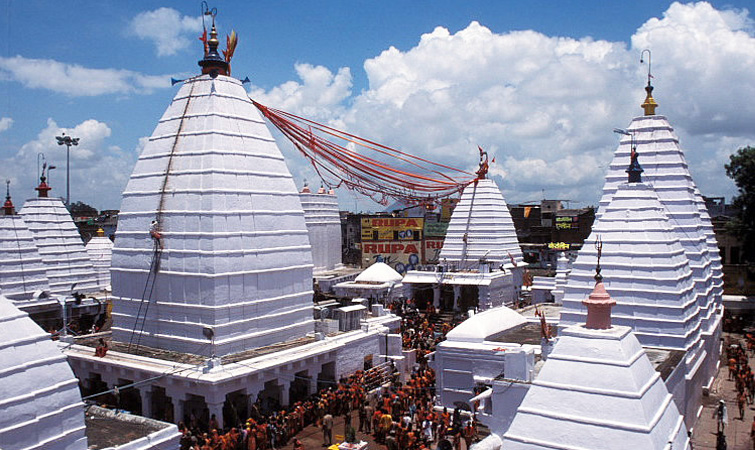
Located at Deoghar in the state of Jharkhand, Baba Baidyanath Dham is one of the famous pilgrimage centres in India for Hindus. Considered as one of the sites of 12 holy Jyotirlingas, the temples dedicated to Lord Shiva and Goddess Parvati are visited by uncountable number of devotees every year especially during the holy Shravan month of Hindu calendar which falls during July and August. This is also the time when devotees commence with a 105 km. long ‘Kanwar Yatra’ carrying holy waters from Ganges in Sultanganj to offer to Lord Shiva in Baidyanath Dham on the auspicious day of Maha Shivratri. Besides the main temple of Lord Shiva, following are few other attractions in the vicinity that should be on the travel list of tourists visiting this place.
- Parvati Temple – Located in the vicinity of the Baidyanath Temple, is the Ma Parvati Temple. You can see red ‘dupattas’ connecting the tower tops of Baidyanath Temple and Parvati Temple indicating their ‘gathbandhan’ or marriage. The Parvati Temple is also one of the 52 Shakti peeths where the heart of Sati is believed to have fallen. The temple is a must-visit after visiting the main Baidyanath Temple.
- Naulakha Temple – Located at a distance of 2 km. from Baba Baidyanath Temple, the Naulakha Temple is dedicated to Radha-Krishna. 146 ft. tall beautiful idols of Radha and Krishna are the main deities of the temple. The construction of the temple incurred a cost of 9 lakhs and hence, the temple is named as ‘Naulakha’. Tranquil settings of the temple give you a feel of solitude and peacefulness.
- Nandan Pahar – A small hill located at a walking distance from the Baidyanath Dham temple complex, Nandan Pahar is famous for its temple dedicated to the Nandi bull. Besides the temple, this place is a nice picnic spot for locals and tourists alike who can enjoy scenic beauty of the town from this place. Kids can indulge in various joy rides available at the hill park.
- Trikutachal Mahadev Temple – The temple dedicated to Lord Shiva is situated atop the ‘Trikut Hills’ near Baidyanath Temple in Deoghar. The three peaks of these hills represent Brahma, Vishnu and Mahesh. The hill can be reached through a vertical ropeway that starts from the base of the hill. The beautiful ‘Mayurakshi River’ also originates from this hill. Surrounded with Applewood forests, enchanting beauty and serenity of this place gives you a feel of extreme peace and solace.
- Basukinath Temple – Situated on the Deoghar-Dumka highway at a distance of around 40 km. from Deoghar, the Basukinath Temple is the second most sacred shrines for Hindus after the Baidyanath Temple in Deoghar. It is believed that pilgrimage remains incomplete if one does not visit the Basukinath Temple after visiting the Baidyanath Temple. The temple sees hordes of pilgrims during Shravan month and on the occasion of ‘Ram Janki Vivah Utsav’ in the months of November-December. Huge processions of fully decked horses and elephants during the festival is a sight to behold.
The pilgrimage tours not only embark you on spiritual journeys but also help you get closer to nature and its creations. Please do take out some time from your busy schedules to get some spiritual bliss and peace.
Write to us for any missing/incorrect information or to share your experiences and suggestions.
Published: 29 Feb, 2016
Kamlesh Nayal is the Senior Tour Manager at TourMyIndia.com. With his great managerial skills he takes care of the domestic clientele of the organization. Along with the administrative expertise, he is blessed with a tremendous writing style. Packed with precise factual information, his write ups are very helpful for both Indian and foreign tourists.



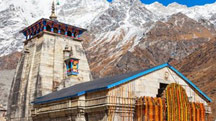 7 Nights / 8 Days
7 Nights / 8 Days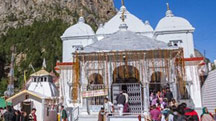 6 Nights / 7 Days
6 Nights / 7 Days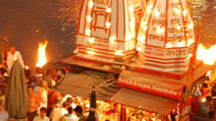 2 Nights / 3 Days
2 Nights / 3 Days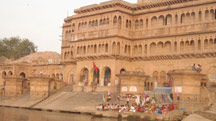 2 Nights / 3 Days
2 Nights / 3 Days




















